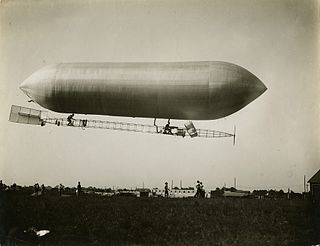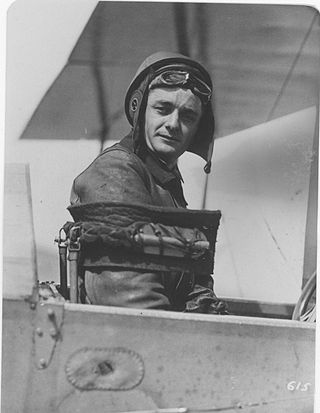
The United States Army Air Service (USAAS) was the aerial warfare service component of the United States Army between 1918 and 1926 and a forerunner of the United States Air Force. It was established as an independent but temporary branch of the U.S. War Department during World War I by two executive orders of President Woodrow Wilson: on May 24, 1918, replacing the Aviation Section, Signal Corps as the nation's air force; and March 19, 1919, establishing a military Director of Air Service to control all aviation activities. Its life was extended for another year in July 1919, during which time Congress passed the legislation necessary to make it a permanent establishment. The National Defense Act of 1920 assigned the Air Service the status of "combatant arm of the line" of the United States Army with a major general in command.

Benjamin Delahauf Foulois was a United States Army general who learned to fly the first military planes purchased from the Wright brothers. He became the first military aviator as an airship pilot, and achieved numerous other military aviation "firsts". He led strategic development of the Air Force in the United States.

Thomas Scott Baldwin was a pioneer balloonist and U.S. Army major during World War I. He was the first American to descend from a balloon by parachute.

The Aeronautical Division, Signal Corps (1907–1914) was the first heavier-than-air military aviation organization in history and the progenitor of the United States Air Force. A component of the U.S. Army Signal Corps, the Aeronautical Division procured the first powered military aircraft in 1909, created schools to train its aviators, and initiated a rating system for pilot qualifications. It organized and deployed the first permanent American aviation unit, the 1st Aero Squadron, in 1913. The Aeronautical Division trained 51 officers and 2 enlisted men as pilots, and incurred 13 fatalities in air crashes. During this period, the Aeronautical Division had 29 factory-built aircraft in its inventory, built a 30th from spare parts, and leased a civilian airplane for a short period in 1911.

The Aviation Section, Signal Corps, was the aerial warfare service of the United States from 1914 to 1918, and a direct statutory ancestor of the United States Air Force. It absorbed and replaced the Aeronautical Division, Signal Corps, and conducted the activities of Army aviation until its statutory responsibilities were suspended by President Woodrow Wilson in 1918. The Aviation Section organized the first squadrons of the aviation arm and conducted the first military operations by United States aviation on foreign soil.
The Division of Military Aeronautics was the name of the aviation organization of the United States Army for a four-day period during World War I. It was created by a reorganization by the War Department of the Aviation Section, U.S. Signal Corps on April 24, 1918, still as part of the Signal Corps. It was removed from the Aviation Section by executive order on May 20, 1918, and existed as the sole Army aviation agency until a War Department general order issued May 24, 1918, established it and the Bureau of Aircraft Production, created by the same reorganization on April 24, as coordinate components of the "Air Service". As such, it is recognized by the United States Air Force as the third of its antecedents.

Frank Purdy Lahm was an American aviation pioneer, the "nation's first military aviator", and a general officer in the United States Army Air Corps and Army Air Forces.

U.S. Air Force aeronautical ratings are military aviation skill standards established and awarded by the United States Air Force for commissioned officers participating in "regular and frequent flight", either aerially or in space, in performance of their duties. USAF aeronautical badges, commonly referred to as "wings" from their shape and their historical legacy, are awarded by the Air Force in recognition of degrees of achievement and experience. Officers earning these badges and maintaining their requirements are classified as rated officers and receive additional pay and allowances.
An air division is an air force or naval air formation that is roughly equivalent to an army division. An air division is usually commanded by a major general and it is composed of multiple wings, groups, air brigades, or equivalently-sized air force formations.

Paul Ward Beck was an officer in the United States Army, an aviation pioneer, and one of the first military pilots. Although a career Infantry officer, Beck twice was part of the first aviation services of the U.S. Army, as de facto head of the flying section of the Aeronautical Division, U.S. Signal Corps in 1911 and as a senior officer of the Air Service in 1920–1922. He is generally credited as being the first military officer to advocate an air force for the United States separate from the control of other branches of the Army.

The Burgess Model I, also known as the Burgess I-Scout and the Coast Defense Hydroaeroplane, was a United States reconnaissance seaplane built for the Aeronautical Division, U.S. Signal Corps in 1913. It was of conventional Wright Model B design but with an engine mounted amidships in an enclosed fuselage, driving by chains two large pusher propellers mounted on the interplane struts. The undercarriage consisted of twin pontoons. The single example built, S.C. No. 17, was delivered to the Army in January 1913 at the Burgess Company and Curtis factory in Massachusetts, then transported to Florida to complete the training of two officers. After the assignment, it was disassembled and moved to the Philippines in September 1913, where it was in and out of service several times before crashing into the sea near Corregidor on January 12, 1915. It is notable as the first U.S. Army aircraft to conduct two-way radio communication with the ground in December 1914.
The Engineering Division was a division of the Aviation Section, U.S. Signal Corps in the United States Department of War. It was formed on 31 August 1918, under the direction of Lt Col Jesse G. Vincent, to study and design American versions of foreign aircraft. It was later renamed Engineering Division, Air Service and then in 1926 Material Division Air Corps. It was based at McCook Field, and in October 1927 moved to Wright Field.

Alfred Victor Verville was an American aviation pioneer and aircraft designer who contributed to civilian and military aviation. During his forty-seven years in the aviation industry, he was responsible for the design and development of nearly twenty commercial and military airplanes. Verville is known for designing flying boats, military racing airplanes, and a series of commercial cabin airplanes. His planes were awarded with the Pulitzer Speed Classic Trophy in 1920 and 1924.

The Flying/Aviation Cadet Pilot Training Program was originally created by the U.S. Army to train its pilots. Originally created in 1907 by the U.S. Army Signal Corps, it expanded as the Army's air assets increased.

Signal Corps Dirigible No. 1 was the first powered aircraft ordered for the Signal Corps by the Aeronautical Division of the United States Army. The purchase of SC-1, a dirigible designed by Thomas Scott Baldwin, was the result of urgings by Chief Signal Officer Brigadier General James Allen. After seeing Baldwin demonstrate a dirigible at the St. Louis air meet in 1907, Allen had urged the U.S. Army to buy a dirigible, as many European armies had dirigibles by the turn of the century.

Townsend Foster Dodd was the first commissioned US Army aviator. As a University of Illinois graduate with a Bachelor of Science in electrical engineering, he joined the Coast Artillery Corps and shortly thereafter became an aviator in the US Army Air Service. Dodd sat on many boards of review during the service's infancy and was one of the members who condemned pusher planes in favor of tractors. He served with General John Pershing on the Mexican Border where he set records for endurance flying. During World War I he was first assigned as the aviation officer of the American Expeditionary Force in 1917. He was later replaced by Colonel Billy Mitchell and was reassigned to the Bolling Mission.

Byron Quinby Jones was a pioneer aviator and an officer in the United States Army. Jones began and ended his career as a cavalry officer, but for a quarter century between 1914 and 1939, he was an aviator in the various organizations that were the Army's air arm. He appeared to be on track in the 1930s to becoming one of the senior commanders of the Air Corps, but his views on the role of airpower diverged from those of his Air Corps peers and he returned to the Army's ground forces at the beginning of World War II.

George Percival Scriven was the seventh Chief Signal Officer of the United States Army (1913–1917). In this position he commanded the Aeronautical Division (1913–1914),and later the Aviation Section (1914–1917) of U.S. Signal Corps, the forerunner of the United States Air Force.

Aviation Act of 1917 was a United States military appropriations bill authorizing a temporary increase for the United States Army Signal Corps. The Act of Congress authorized provisions for airship or dirigible operations governed by the U.S. Army Signal Corps Aeronautical Division. The legislation provided United States President Woodrow Wilson emergency authority for the maintenance, manufacture, operation, purchase, and repair of airships and associated aerial machines.
















